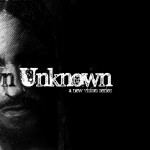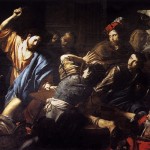Have you noticed how the second Star Wars trilogy (episodes I-III) parallels the first (episodes IV-VI)? Here are a few examples.
A New Hope (IV) and the Phantom Menace (I)
- Both Luke and Anakin Skywalker leave their family on Tatooine to be trained by Obi-wan as a Jedi.
- Obi-wan is killed by a Sith lord in front of his apprentice Luke just as Qui Gon is killed by a Sith lord in front of his apprentice Obi-wan
- Both films climax with Skywalkers (Luke and Anakin) in a space battle in which they blow up the enemy space-station
- Full cast appears in triumphant award ceremony
The Empire Strikes Back (V) and Attack of the Clones (II)
- Male leads are separated during “romantic” chapter of the film.
- Both Boba and Jango Fett follow heros in Slave I through astroid field while heros hide behind an asteroid and escape with the garbage.
- The first begins with a battle against giant robot walkers and the later ends with battle against giant robot walkers
- C-3PO is dismantled in a droid factory
- Both Luke and Anakin Skywalker lose an appendage and get a robotic replacement.
Return of the Jedi (VI) and Revenge of the Sith (III)
- The original title of Return of the Jedi was Revege of the Jedi
- The Emperor makes his first real appearance both these films
- Both Luke and Anakin Skywalker wear a black glove to cover their robotic hands.
- Luke battles Vader while Palpatine watches just as Anakin battles Dooku while Palpatine watches
- Luke cuts off Vader’s robotic hand in light saber duel just as Obi wan cuts off Grevous’ robotic hand in the same way
- Ewoks battle from tree homes on Endor just as Wookies battle from tree homes on Kashyyk
- Vader unmasked in the former while Vader is masked in the later
- Ends with funeral
The list of parallels goes on. You can find a more complete list here webpage. It’s pretty clear that the two Star Wars trilogies were arranged in a parallel a-b-c-a’-b’-c’ pattern.
Parallel Patterns in the Old Testament
I bring this up because I think it’s interesting that at least some people still recognize and value such implicit parallels. For the ancient writer and reader it was no different. These parallels in Star Wars are great illustration of the way the biblical writers structured some of their writings. Here’s what David Dorsey says in his extremely helpful book the Literary Structure of the Old Testament.
Parallel arrangements are relatively common in the Hebrew Bible. They generally feature two sets (or panels) of units, in which the units of the first set are matched in the same order by those of the first set (a-b-c II a’-b’-c’ or variations). When a parallel scheme has an odd number of units, the unmatched unit can be placed at the end (a-b-c II a’-b’-c’ II d), center (a-b-c-d-a’-b’-c’), or (more rarely) beginning (a-b-c-d II b’-c’-d’).
Parallelism frequently occurs in Hebrew poetry. Note for example, the a-b-c II a’-b’-c’ pattern in Psalm 19:1-2 {19:2-3}:
a the heavens
b tell of
c God’s glory
a’ the sky
b’ proclaims
c’ his handiwork
a day by day
b they pour forth
c speech
a’ night by night
b’ they declare
c’ knowledge
The pattern can also be found in larger unites. For example, the creation story in Genesis 1:1-2:4, although primarily linear (first day, second day, etc.), exhibits a secondary parallel pattern (a-b-c II a’-c’c’ II d):
a light
b sea and sky
c dry land
a’ lights
b’ fish and birds
c’ land animals and humans
d Sabbath
Whole books may likewise be arranged in this way. The seven parts of Jonah are primarily linear in arrangement (following a chronological order), but also exhibit a secondary parallel pattern (a-b-c II a’-b’-c’ II d):
a Jonah’s commissioning and disobedience (1:1-3)
b Jonah and pagan sailors: Yahweh is merciful (1:4-16)
c Jonah’s response to Yahweh’s mercy: praise (1:17-2:10 {2:1-11})
a’ Jonah’s recommissioning and obedience (3:1-3a)
b’ Jonah and pagan Ninevites: Yahweh is merciful (3:3b-10)
c’ Jonah’s response to Yahweh’s mercy: resentment (4:1-4)
d Yahweh’s lesson (4:5-11)
Parallel Patterns in the New Testament
But its not just in the Old Testament. I’m fascinated by the way the Gospel writers conveyed meaning through the arrangement of there parts. Here’s one very significant example.
We all know that Luke begins his story with two annunciation scenes. But did you know that Luke uses parallels to arrange them in a meaningful structure. Look at this:
a Description of Zacharias and his situation (1:5-10)
b Angel’s message to Zacharias (1:11-22)
c Zacharias returns home and Elizabeth reacts to the news (1:23-25)
a’ Description of Mary and her situation (1:26-27)
b’ The Angel’s message to Mary (1:28-38)
c’ Mary goes to Zacharias’ home and Elizabeth reacts to the news (1:39-
d Mary’s sings a song
When we miss the pattern we miss some of the message that Luke’s attempting to convey. And the same goes for other patterns in the New Testament. For more on how Luke uses this parallel pattern to convey meaning check out these two posts: What Happens When You’re Filled with the Spirit and Why God Shut Zachariah’s Mouth.





















